Where In The World of George Pal Is Woody Woodpecker? Animation producer Walter Lantz and filmmaker George Pal were very good friends.
As the terrific animation historian Joe Adamson wrote in his book The Walter Lantz Story (G.P. Putnam’s Sons 1985): “Walter had been close friends with Pal ever since Pal had left Europe in advance of the war and arrived in Hollywood announcing that his two ambitions in life were to meet Walter Lantz and continue producing puppet animation.
“Walter met George and, in return for his admiration, sponsored Mr. and Mrs. Pal’s American naturalization, got George into the Cartoon Producers Association, introduced him to people who were able to get his Puppetoon series started at Paramount, and became godfather to his first-born son”.
Animation fans are well aware of the animated short in Pal’s iconic Destination Moon (1950) that features Woody Woodpecker showing the scientific principles about how rockets work. After the success of that film, Pal “hid” Woody in some of his other films as a good luck charm.
In When Worlds Collide (1951), Woody can be glimpsed at the airport when the character of Randall is being picked up.
In War of the Worlds (1953), Woody is in the branches of a tree center screen when the first Martian cylinder meteor flies over the woods.
In Tom Thumb (1958), as all the toys greet Tom, the Woody Woodpecker laugh can be heard in the background.
In The Time Machine (1960), a stuffed Woody doll is in the arms of a young girl rushing to get to a bomb shelter before the atomic bombs go off. She briefly drops the doll and then retrieves it.

“The Time Machine”
In The Power (1968), George Hamilton’s character looks at a store window display and a mechanical Woody Woodpecker toy squirts water at him.
In Doc Savage (1975), the last scene is a boy scout helping Gracie Lantz across the street. In her hands is an Andy Panda doll as if she had just purchased it for a child. Andy was used because Woody had not yet been created during the time frame in which the film takes place. Some people joke that the lack of a real Woody Woodpecker jinxed the film.
Lantz confessed to Adamson, “Sometimes he (Pal) had to tell me where (Woody) was”.
Live Long and Prosper, Bugs Bunny. In 1990, animation legend Chuck Jones was asked if back in 1940 he had any idea that people would someday be celebrating Bugs Bunny’s 50th birthday. Jones responded, “No, if somebody had asked me about any of the Warner Brothers pictures being alive in fifty years, I would have said it’s about as likely as a man landing on the moon. Why? In 1940, there wasn’t any television. So we expected our films would be retired. Each studio was making about thirty cartoons a year, so the idea of replaying them was bad business.”
 What a Director Does. Animation legend Friz Freleng stated in a 1990 interview: “What makes a good animation director? Well, you have to be that character. When you’re putting that down, you’re doing the acting with a pencil. And the ability you have of getting those expressions and attitudes down on paper, you can transfer to the next guy, the animator. But if you don’t put that down, he’s not going to be able to do it. You’re Santa Claus with a lot of elves. My personality must come through. It has to come from me. That’s why nobody can ever do Yosemite Sam the same as I did.”
What a Director Does. Animation legend Friz Freleng stated in a 1990 interview: “What makes a good animation director? Well, you have to be that character. When you’re putting that down, you’re doing the acting with a pencil. And the ability you have of getting those expressions and attitudes down on paper, you can transfer to the next guy, the animator. But if you don’t put that down, he’s not going to be able to do it. You’re Santa Claus with a lot of elves. My personality must come through. It has to come from me. That’s why nobody can ever do Yosemite Sam the same as I did.”
Interviewing Walt. In 1992 I asked Bob Thomas at a NFFC convention how he went about interviewing Walt. “An interview with Walt consisted of you asking questions and Walt talking about anything he wanted regardless of whatever you asked.”
Thomas spent four years researching and writing the classic biography Walt Disney: An American Original. Thomas wrote several other Disney related books and jokingly said that when the Disney Company writes the book contract, it always favors Disney but he still willingly signed them because he wanted to write about the topics.
Stomach Trouble. Comic book legend Wally Wood is well known as a master comic book artist who was equally adept in both realistic and humorous illustration.
In addition to his memorable comic book work, he also did work in advertising, gag cartoons for magazines, trading cards, record album covers, science fiction illustrations for magazines and much more.
However, Wood also had some occasional brushes with animation.
In 1967, Wood did a colorful print magazine ad for Alka-Seltzer entitled “Stomachs get even at night”.
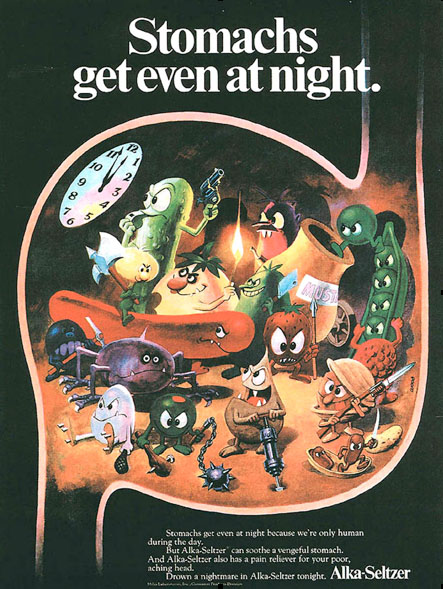
It featured almost a dozen of Wood’s “cartoony” vegetable monsters inside a stomach watching as a clock neared the midnight hour. Then, they plan on a rampage with a cannon, jackhammer and more instruments of pain. “Stomachs get even at night because we are only human during the day” stated the text.
The advertisement won the Art Directors Club Medal that year and garnered a lot of attention.
It was so popular that Wood’s obituary in the Los Angeles Times newspaper was headlined “Gut Level Characters Made Him Famous”.
In 1968, Alka-Seltzer decided to transfer it into an animated commercial. Wood was hired to sketch the storyboard. The advertisement agency wanted the vegetable characters to do something even though the print ad had just depicted them frozen in that fateful moment before their attack.
For the storyboard, Wood created a human character in striped pajamas sitting on the edge of the bed after winding an alarm clock.
At the base of the bed coming over the back board are a horde of never-ending food monsters who start marching toward the man like an army across a battlefield. (click thumbnails below to enlarge)
Wood turned in the storyboard but like much of the work-for-hire he did, he cashed the check and never followed up on how the final commercial would be handled.
“It’s hard to fall asleep when some of the things you’ve eaten insist on staying up past your bedtime. If there are little things still kicking around, your stomach is going to keep you awake…unless you take Alka-Seltzer,” intoned the narrator in the commercial.
Unfortunately, the sly malevolence in Wood’s character designs had been watered down to look cute and silly rather than forbidding and a genuine threat. They are easily stopped and turned away with a pointed finger after the man takes an alka-seltzer tablet.
In Wood’s original storyboard sketches, the characters explode from the man’s stomach.



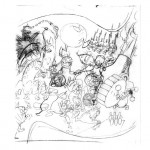
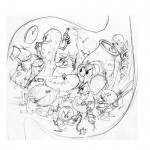
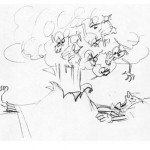
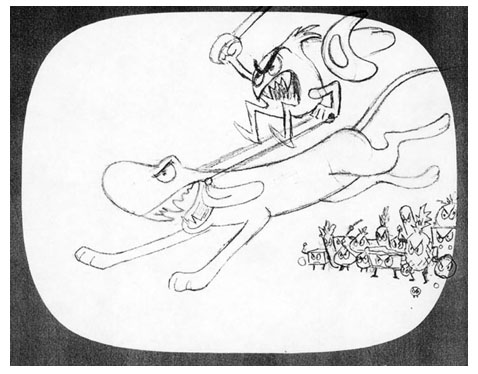
 Jim Korkis is an internationally respected animation historian who in recent years has devoted his attention to the many worlds of Disney. He was a columnist for a variety of animation magazines. With his former writing partner, John Cawley, he authored several animation related books including The Encyclopedia of Cartoon Superstars, How to Create Animation, Cartoon Confidential and Get Animated’s Animation Art Buyer’s Guide. He taught animation classes at the Disney Institute in Florida as well as instructing classes on acting and animation history for Disney Feature Animation: Florida.
Jim Korkis is an internationally respected animation historian who in recent years has devoted his attention to the many worlds of Disney. He was a columnist for a variety of animation magazines. With his former writing partner, John Cawley, he authored several animation related books including The Encyclopedia of Cartoon Superstars, How to Create Animation, Cartoon Confidential and Get Animated’s Animation Art Buyer’s Guide. He taught animation classes at the Disney Institute in Florida as well as instructing classes on acting and animation history for Disney Feature Animation: Florida.




















































Early in his career, David Lynch was a bit obsessed with Woody Woodpecker and traveled around with six identical Woody dolls in his car. They can be seen here: http://pickledelephant.tumblr.com/post/37123712788/david-lynch-universal-studios-1981
A trooper! Too bad he didn’t think to get into animation besides the one or two shorts he did in his early days.
Inspired by your comment, I went sniffing around the internet. looking for more info on this. Apparently, carrying the dolls around was Lynch’s way of beating interviewers to the quickly-cliched comparison made between his tall flop of hair and Woody’s similarly feathered ‘do.
The weirdest Lynch/Woody moment I could find is a short video that he made for the Nuart Theater, thanking them for their support with Eraserhead. In it, Lynch introduces the Woody dolls as his ‘boys,’ then gives a different name for each, then describes their personal understanding of ‘the suffering in the world’ (or something like that), and mentions that they’d spent years ‘hanging from metal hooks in their backs on Sunset Blvd.’ — all without cracking even the faintest smile!
Here’s a link to that video for those interested: https://www.youtube.com/watch?v=lrE9PHsbCXA
Ju-osh, so good! Looks like my count was off by one. The “hooks on their backs” bit is explained in some other interview, where Lynch said he saw them hanging from hooks in a shop, and they just looked so painful that he had to “rescue” them.
Nice piece
Excellent installment! I really enjoyed the Andy Panda Theory to explain what happened to Doc Savage.
Interesting story about “Doc Savage, the Man of Bronze”–except that even using an Andy Panda doll was an anachronism.
The film is set in 1936, and Andy Panda does not appear on film until 1939.
If the film’s writers had wanted to avoid an anachronism, they would have had to use an Oswald Rabbit doll–if there was such a product on the market, then, that is!
And nobody remembered Oswald except a few really serious animation students. The cartoons had not been seen on television in at least ten–maybe in fifteen-years. Oswald’s only color appearances were not noted as such, so they would have been pretty much ignored by the target audience (mostly kids who’d watch just about anything that moved and had a loud soundtrack!)
There were plenty of reasons why “Doc Savage, the Man of Bronze” failed at the box-office–such as treatment (camp!), casting, etc, etc, etc. . .
Reminded of a podcast review on that film I’ve heard a while back.
http://gmepodcast.com/2012/08/20/tan-man-w-desk-fan/